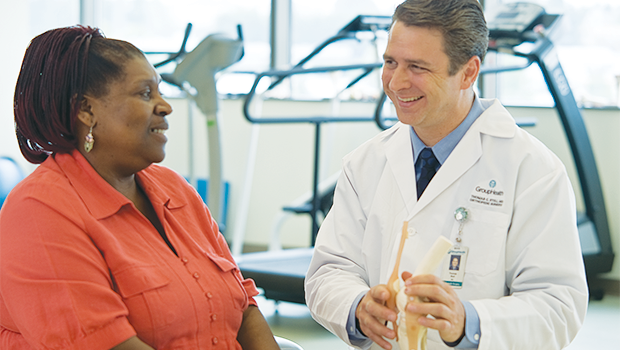Implementation science: Learning to spread and sustain our best new ideas

Dr. Robert Reid reflects on Group Health’s growing bank of innovation knowhow, including shared decision-making (shown here with Wanda Current and Dr. Thomas Stoll).
Amid so much change—inside and outside Group Health—it’s easy to forget how far we’ve come in our ability to implement important, new advances.
Case in point: In the mid-1990s, Group Health tested a shared decision-making intervention for non-cancerous prostate gland enlargement, also called benign prostate hyperplasia. The idea was to systematically give patients objective, easily understood information on various treatments’ pros and cons, and then evaluate how this information influenced their treatment decisions. The results? Patient satisfaction increased as surgery rates fell. Unfortunately, the intervention was never fully implemented across Group Health, so this landmark work benefited few patients.
Contrast this with recent advances in the same field. In 2010, Group Health began routinely providing decision aids for patients with prostate problems, low back pain, and about a dozen other common conditions. Group Health Research Institute (GHRI)’s 2012 evaluation showed the aids sharply reduced hip- and knee-surgery rates and costs. We now distribute more decisions aids than any other health system in the world.
What changed? The answer lies in an emerging field called “implementation science.” That’s a fancy term for figuring out how proven ideas can be widely accepted, spread, and sustained—not fall by the wayside. As GHRI Executive Director Dr. Eric B. Larson once said: “It’s not the innovation that matters. It’s what happens after the innovation.”
Our 2012 shared decision-making venture succeeded for many reasons: from the foundation grants that supported project development and evaluation to external incentives, such as a state mandate and market pressures to curb costs. Perhaps most important, Group Health clinical leaders supported and led the implementation, using robust methodology.
Today’s Group Health better understands what it takes to develop, spread, and sustain important advances. Our knowledge has grown incrementally with our work on the patient-centered medical home, the oncology nurse navigator model, changes in opioid prescribing, and other initiatives. With each development, we learn more about our organization and how to make improvements real and sustainable for our patients. We build this knowledge into designing and evaluating new interventions. One recent example: Dr Greg Simon’s new suicide prevention trial.
In a journal aptly named Implementation Science, Veterans Affairs researcher Laura Damschroeder and colleagues richly describe the framework necessary to implement new research findings successfully. “Many existing theories propose ‘what works,’” they write. “But more research is needed into what works where and why.” Five key domains need attention: the intervention itself, the organization’s internal setting, its external setting, the individuals involved, and the processes used for implementation.
Ms. Damschroeder’s work confirms what we’ve already discovered at Group Health—and raises useful questions as we assess our efforts:
- “Is the intervention compatible with existing norms and values? What are the risks?”
Consider how our opioid-safety initiative aligns with Group Health’s commitment to patient safety; how shared decision-making matches the value we place on patient-centered care; and how Group Health’s emphasis on evidence-based medicine supports so many of our successful advances.
- “Is there room for users to experiment on a limited basis before adopting?”
One Group Health example: In implementing the oncology nurse navigator role, we learned the importance of adapting a core intervention to fit individual patients’ needs.
- “How quickly are the benefits observable?”
Just 10 months after we implemented the opioid-safety initiative, nearly all Group Health patients taking these medications had care-management plans. This early tangible success fostered confidence to sustain the practice. It also helped us attract Patient-Centered Outcomes Research Institute (PCORI) funding in 2014 to study the initiative’s impact on patient outcomes.
- “How much knowledge is required? How complex is the training?”
For shared decision making, the ease of new technologies may have boosted success: Clinicians get electronic reminders to recommend video decision aids that patients can see on Group Health’s website.
- “Are the necessary individuals engaged?”
Support from leaders and managers, change agents, champions, and boundary spanners has been crucial to every successful change we’ve implemented.
Moving forward
Group Health’s implementation science over the past decade gives us an edge that other organizations seek to emulate. It contributes to our reputation locally, nationally, and worldwide. More importantly, it gives our people the systems and tools needed to truly promote the health of the populations we serve.
This expertise is required now more than ever. While implementing the Affordable Care Act, health care organizations everywhere seek innovations that improve quality, lower cost, and enhance patient experience. It’s a dynamic environment with unprecedented incentives and opportunities for change. We need to reliably implement innovations that work—and sustain them over time.
Given our commitment to continually improving patient care, this is our task to do. Let’s keep using our hard-won knowledge and experience to its best advantage.
—Robert J. Reid, MD, PhD
Group Health Research Institute Senior Investigator
Group Health Medical Director, Research Translation



